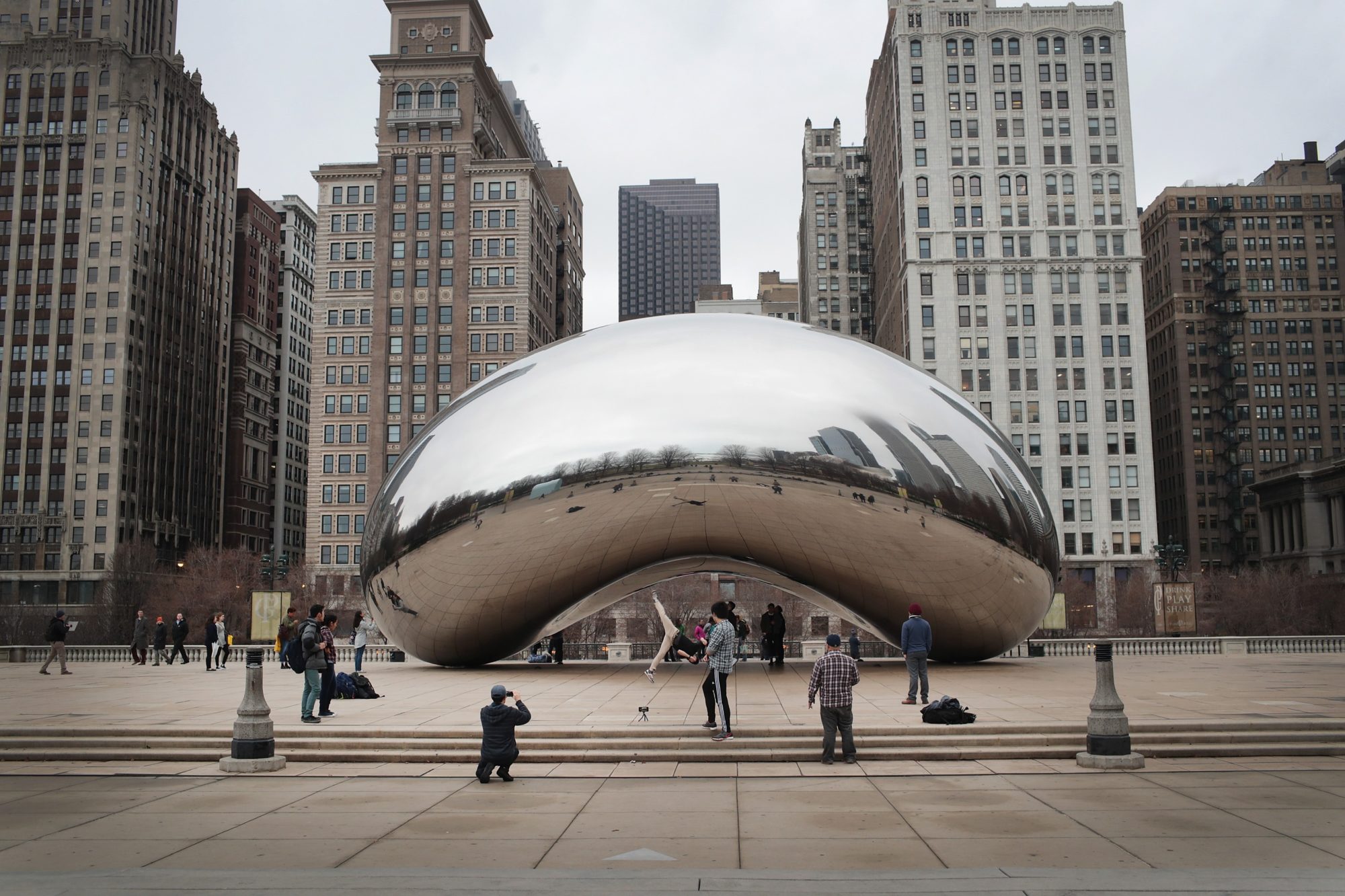Media Frame: Chicago ‘Bean’ Graffiti Outrage Prioritizes Property Over People
Outlets ran over 200 articles covering the vandalism. The outsize attention will likely damage young lives.

The public’s perception of crime is often significantly out of alignment with the reality. This is caused, in part, by frequently sensationalist, decontextualized media coverage. Media Frame seeks to critique journalism on issues of policing and prisons, challenge the standard media formulas for crime coverage, and push media to radically rethink how they inform the public on matters of public safety.
In the early hours of July 2, seven people allegedly spray-painted graffiti on “Cloud Gate,” a sculpture informally known as “The Bean,” and parts of nearby Maggie Daley Park in Chicago. The city removed the paint in a matter of hours.
What would otherwise be a routine case of petty vandalism spiraled into a life-altering arrest for two local 20-year-olds, who now face felony charges, $10,000 cash bonds, electronic monitoring, and scores of online articles featuring their mugshots and names. (The other five arrestees, four whose names were also published, were charged with misdemeanor criminal trespass and released on recognizance bonds.)
A review of local and national coverage by The Appeal found that the Bean graffiti episode was covered in over 200 outlets––including national coverage by CNN, the New York Times, Fox News, and ABC News—many featuring the names and mugshots of the accused. It wasn’t only an issue of quantity. Qualitatively, the local coverage involved several on-scene reports as well as follow-up coverage, live from the courthouse, demanding comment from city officials and vox populi. It wasn’t just brief mentions, but resource-heavy features of on-the-ground reporting.
Sharlyn Grace, co-founder of the Chicago Community Bond Fund, a nonprofit focused on reforming cash bail, calls the charges against those arrested “excessive.” She says “it seems the money bond and [electronic monitoring] were ordered due to the public conversation about this case and are therefore punitive and inappropriately political.”
The media’s weeklong Bean outrage is an object lesson in the wildly disproportionate manner that the press—in a feedback loop with city officials—prioritizes wealthy, majority-white spaces and property over the human cost to Black and Latinx defendants.
There’s a very real consequence to this type of exposure. As I’ve documented in interviews with other arrestees, having one’s mugshot and name plastered in the media makes future employment and potential relationships that much more difficult. This extrajudicial form of social punishment is compounded, of course, by the underlying criminal prosecution of a felony. Felonies have long-term consequences beyond just jail time. They severely undermine one’s ability, once out of prison, to obtain employment and gain access to state and federal welfare programs. In many states, people who have been convicted of felonies cannot vote or hold government jobs.
City officials compounded the fervor. Judge David Navarro mugged for the media, telling the defendants at their public bond hearing, “I take offense at these offenses.” Mayor Lori Lightfoot told reporters she felt “outrage” and that “there are some things that should be sacred.”
When reporters asked Lightfoot the obvious follow-up question—why she was outraged by this graffiti but not the graffiti in overwhelmingly Black neighborhoods—she assured them she wasn’t being inconsistent. “It’s unacceptable wherever it is,” she said at the press conference for an unrelated event.
But it appears neither Lightfoot nor her predecessor Rahm Emmanuel have created the same uproar over graffiti in poor and Black areas. Both have proposed graffiti-removal plans on the South and West sides, but these are quality-of-life laws that increase punishment for these very same communities. A search of the Chicago Tribune and local TV news archives over the last three years, however, returned no mentions by either mayor of a specific case of vandalism, much less comments on how outraged they were.
As a point of reference, in 2013, a statue of Chicago’s first Black mayor, Harold Washington, was defaced on the South Side. The result? A mere six media reports—all local. There was no comment from then-Mayor Emmanuel much less “outrage” or evocations that the statue was “sacred.”
There only seems to be one episode of vandalism, at least in recent years, that has struck a chord with city officials and the media: that which has (extremely briefly) tarnished a popular tourist attraction in a neighborhood much wealthier and much whiter than the rest of Chicago. The Loop neighborhood that the Bean and Maggie Daley Park belong to is only 18 percent Black and Latinx, but the city as a whole is roughly 60 percent Black and Latinx. The mean household income in The Loop is twice that of the rest of Chicago.
A line was crossed, and city officials and local media engaged in an all too familiar script of feeding each other’s outrage. Once public interest and the performative indignation wanes, what’s left, however, is the real human cost: two 20-year-olds whose lives will never be the same, all because they allegedly made the mistake of engaging in small-time vandalism in a wealthy, predominantly white area of town.
